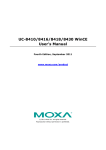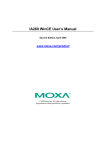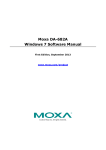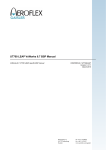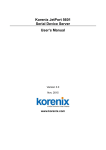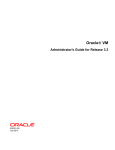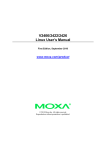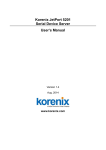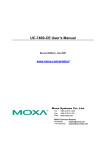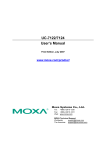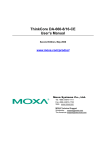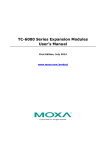Download UC-8410/8416/8418/8430 WinCE User`s Manual
Transcript
UC-8410/8416/8418/8430 WinCE
User’s Manual
Fifth Edition, January 2012
www.moxa.com/product
© 2011 Moxa Inc. All rights reserved.
Reproduction without permission is prohibited.
UC-8410/8416/8418/8430 WinCE
User’s Manual
The software described in this manual is furnished under a license agreement and may be used only in accordance with
the terms of that agreement.
Copyright Notice
Copyright ©2010 Moxa Inc.
All rights reserved.
Reproduction without permission is prohibited.
Trademarks
The MOXA logo is a registered trademark of Moxa Inc.
All other trademarks or registered marks in this manual belong to their respective manufacturers.
Disclaimer
Information in this document is subject to change without notice and does not represent a commitment on the part of
Moxa.
Moxa provides this document as is, without warranty of any kind, either expressed or implied, including, but not limited
to, its particular purpose. Moxa reserves the right to make improvements and/or changes to this manual, or to the
products and/or the programs described in this manual, at any time.
Information provided in this manual is intended to be accurate and reliable. However, Moxa assumes no responsibility for
its use, or for any infringements on the rights of third parties that may result from its use.
This product might include unintentional technical or typographical errors. Changes are periodically made to the
information herein to correct such errors, and these changes are incorporated into new editions of the publication.
Technical Support Contact Information
www.moxa.com/support
Moxa Americas
Moxa China (Shanghai office)
Toll-free: 1-888-669-2872
Toll-free: 800-820-5036
Tel:
+1-714-528-6777
Tel:
+86-21-5258-9955
Fax:
+1-714-528-6778
Fax:
+86-10-6872-3958
Moxa Europe
Moxa Asia-Pacific
Tel:
+49-89-3 70 03 99-0
Tel:
+886-2-8919-1230
Fax:
+49-89-3 70 03 99-99
Fax:
+886-2-8919-1231
Table of Contents
1.
Introduction ...................................................................................................................................... 1-1
Overview ........................................................................................................................................... 1-2
Model Descriptions and Package Checklist .............................................................................................. 1-2
Software Specifications........................................................................................................................ 1-3
Application Development Environment ........................................................................................... 1-3
Networking and Communications Capabilities.................................................................................. 1-3
Supported Servers and Daemons .................................................................................................. 1-4
Graphics and Multimedia Tools(UC-8430-CE only) ........................................................................... 1-4
Firmware Build Versions ...................................................................................................................... 1-5
Memory and File Systems .................................................................................................................... 1-5
Dual Display (UC-8430-CE only) ........................................................................................................... 1-5
Audio (UC-8430-CE only)..................................................................................................................... 1-5
Hive-based Registry (not RAM-based) ................................................................................................... 1-5
Inserting a CompactFlash Card ............................................................................................................. 1-6
Inserting a USB Mass Storage Device .................................................................................................... 1-6
RS-232/422/485 Serial Ports................................................................................................................ 1-6
2.
Getting Started.................................................................................................................................. 2-1
Powering on the UC-8410/8416/8418/8430 ........................................................................................... 2-2
Resetting the UC-8410/8416/8418/8430-CE Computer ........................................................................... 2-2
Boot Loader ....................................................................................................................................... 2-2
Operating the UC-8410/8416/8418/8430-CE Computer via the Serial Console ........................................... 2-2
Changing the Network Settings ............................................................................................................ 2-3
Virtual Private Network (VPN) (UC-8430-CE only) ................................................................................... 2-4
Operating the UC-8410/8416/8418/8430-CE Computers via Telnet ........................................................... 2-5
User/Group Management ..................................................................................................................... 2-5
Adjusting the Time Zone...................................................................................................................... 2-6
Adjusting the System Time .................................................................................................................. 2-6
Starting and Stopping Services ............................................................................................................. 2-6
Troubleshooting Network Connectivity ................................................................................................... 2-7
Simple Network Management Protocol (SNMP) ....................................................................................... 2-8
SNMP Agent................................................................................................................................ 2-8
SNMP Manager ............................................................................................................................ 2-8
Accessing Files through File Sharing ...................................................................................................... 2-9
3.
Management Tools ............................................................................................................................ 3-1
System Information ............................................................................................................................ 3-2
Serial Port Configuration ...................................................................................................................... 3-2
Process (Thread) Monitoring/Control ..................................................................................................... 3-3
Services Monitoring/Control ................................................................................................................. 3-3
Display .............................................................................................................................................. 3-4
User/Group Management ..................................................................................................................... 3-4
Auto Launch Configuration ................................................................................................................... 3-5
Web Server Configuration .................................................................................................................... 3-6
DHCP Allocator Configuration ............................................................................................................... 3-7
4.
Web-based Management System ...................................................................................................... 4-1
System Information ............................................................................................................................ 4-2
Networking/Server Configuration .......................................................................................................... 4-2
Serial Port Configuration ...................................................................................................................... 4-3
Process (Thread) Monitoring/Control ..................................................................................................... 4-3
Launching Processes Automatically ....................................................................................................... 4-3
Services Monitoring/Control ................................................................................................................. 4-4
Binary/Text File Management ............................................................................................................... 4-4
A.
Firmware Upgrade Procedure............................................................................................................ A-1
B.
Application Development with the SDK and Software Libraries ......................................................... B-1
Installing the SDK ............................................................................................................................... B-2
Developing an Application with VS2005 ................................................................................................. B-2
Visual C++ Library.............................................................................................................................. B-2
UART ......................................................................................................................................... B-2
DIO ........................................................................................................................................... B-3
Watchdog ................................................................................................................................... B-4
Buzzer ....................................................................................................................................... B-4
CANbus (UC-8418 only) ............................................................................................................... B-5
Visual C++ Examples .......................................................................................................................... B-8
Net Compact Framework Library ........................................................................................................... B-8
UART ......................................................................................................................................... B-8
DIO ........................................................................................................................................... B-9
Watchdog ................................................................................................................................. B-10
Buzzer ..................................................................................................................................... B-10
Visual C# Examples .......................................................................................................................... B-11
1
1.
Introduction
Microsoft® Windows® CE 6.0 is an open, scalable, 32-bit operating system (OS) that allows you to build a wide
range of innovative, small footprint devices. A typical Windows® CE-based device is designed for a specific use,
and often runs disconnected from other computers, or distributed as a front-end to a centralized host.
Examples include enterprise tools, such as industrial controllers, communications hubs, point-of-sale terminals,
and display devices, such as HMI, advertisement appliances, and interactive panels.
Moxa’s UC-8410/8416/8418/8430 ready-to-run embedded computers provide Windows® developers with an
excellent Windows® CE solution. Moxa’s extensive experience in kernel development on embedded small
footprint communication devices provides the intense technological skills required while porting the Windows®
CE 6.0 kernel.
The following topics are covered in this chapter:
Overview
Model Descriptions and Package Checklist
Software Specifications
Application Development Environment
Networking and Communications Capabilities
Supported Servers and Daemons
Graphics and Multimedia Tools(UC-8430-CE only)
Firmware Build Versions
Memory and File Systems
Dual Display (UC-8430-CE only)
Hive-based Registry (not RAM-based)
Inserting a CompactFlash Card
Inserting a USB Mass Storage Device
RS-232/422/485 Serial Ports
UC-8400 WinCE
Introduction
Overview
The UC-8410/8416/8418/8430 embedded computers feature 8 RS-232/422/485 serial ports, 3 10/100 Mbps
Ethernet ports, 4 digital input channels and 4 digital output channels (12 digital input channels and 12 digital
output channels for the UC-8418), 8 10/100 Mbps switch ports (UC-8416 only), a CompactFlash slot for flash
disk expansion, and 2 USB ports (6 USB ports for the UC-8430) for adding additional memory (such as a USB
flash drive).
The UC-8410/8416/8418/8430 use an Intel XScale IXP435 533 MHz RISC CPU. Unlike the X86 CPU, which uses
a CISC design, the IXP435’s RISC design architecture and modern semiconductor technology provide the
UC-8410/8416/8418/8430 with a powerful computing engine and communication functions, but without
generating a lot of heat. The built-in 16 MB (32 MB for UC-8430) NOR Flash ROM, 16 MB NAND flash, and 256
MB SDRAM give you enough memory to run your application software directly on the
UC-8410/8416/8418/8430. Since the dual LAN ports are built into the IXP435 CPU, the
UC-8410/8416/8418/8430 computers are ideal for network security applications.
The UC-8410/8416/8418/8430 come with the Linux 2.6 or Windows CE 6.0 platform pre-installed to provide an
open software operating system for software program development. Software written for a desktop PC can be
easily ported to the UC-8410/8416/8418/8430 platform with a common compiler, without needing to modify
the code. This makes the UC-8410/8416/8418/8430 optimal for industrial applications, but with minimal cost
and effort.
Wide temperature models designed to operate reliably in temperatures ranging from -40 to 75°C eare also
available.
Model Descriptions and Package Checklist
UC-8410-CE
RISC-based industrial embedded computer with 8 serial ports, 4 DIs, 4 DOs, 3 LANs, CompactFlash, USB,
Windows CE 6.0 OS, -10 to 60°C operating temperature
UC-8416-CE
RISC-based industrial embedded computer with 8 serial ports, 4 DIs, 4 DOs, 3 LANs, 8 switch ports,
CompactFlash, USB, Windows CE 6.0 OS, -10 to 60°C operating temperature
UC-8418-CE
RISC-based industrial embedded computer with 8 serial ports, 12 DIs, 12 DOs, 3 LANs, 2 CAN ports,
CompactFlash, USB, Windows CE 6.0 OS, -10 to 60°C operating temperature
UC-8430-CE
RISC-based industrial embedded computer with 8 serial ports, 4 DIs, 4 DOs, 3 LANs, CompactFlash, Dual VGA,
Audio, 6 USB, Windows CE 6.0 OS, -10 to 60°C operating temperature
UC-8410-T-CE
RISC-based industrial embedded computer with 8 serial ports, 4 DIs, 4 DOs, 3 LANs, CompactFlash, USB,
Windows CE 6.0 OS, -40 to 75°C operating temperature
UC-8416-T-CE
RISC-based industrial embedded computer with 8 serial ports, 4 DIs, 4 DOs, 3 LANs, 8 switch ports,
CompactFlash, USB, Windows CE 6.0 OS, -40 to 75°C operating temperature
UC-8418-T-CE
RISC-based industrial embedded computer with 8 serial ports, 12 DIs, 12 DOs, 3 LANs, 2 CAN ports,
CompactFlash, USB, Windows CE 6.0 OS, -40 to 75°C operating temperature
UC-8430-T-CE
RISC-based industrial embedded computer with 8 serial ports, 4 DIs, 4 DOs, 3 LANs, CompactFlash, Dual VGA,
Audio, 6 USB, Windows CE 6.0 OS, -40 to 75°C operating temperature
1-2
UC-8400 WinCE
Introduction
All models are shipped with the following items:
•
1 UC-8410 or UC-8416 or UC-8418 or UC-8430 embedded computer
•
Wall-mounting kit
•
DIN-Rail mounting kit (attached to the product’s housing)
•
Ethernet Cable: RJ45 to RJ45 cross-over cable, 100 cm
•
CBL-4PINDB9F-100: 4-pin header to DB9 female console port cable, 100 cm
•
Universal power adaptor (including power jack converter)
•
Quick installation guide
•
Document and software CD
•
Warranty card
NOTE: Notify your sales representative if any of the above items are missing or damaged.
Software Specifications
UC-8410/8416/8418/8430 WinCE ready-to-run embedded computers are network-centric computers that can
be programmed for embedded communication applications. The software features of the
UC-8410/8416/8418/8430-CE computers are listed below:
Application Development Environment
The UC-8410/8416/8418/8430-CE computers are easy to program. The Windows® CE environment provides
the following common, popular application development features that make programming as convenient and
easy as in a PC environment.
•
C Libraries and Run-times—Compared to the C libraries and run-times used on a desktop PC running
Windows®, the C libraries and run-times on a UC-8410/8416/8418/8430-CE are a subset of the WIN32
APIs. They support full ANSI C run time, standard input/output library, standard input/output ASCII library,
and standard ASCII string functions. In addition, they support C++ compiler exception handling and
Run-Time Type Information (RTTI) equivalent to desktop C++ compilers.
•
Component Services (COM and DCOM)—The Common Object Model (COM) is an operating
system-independent, object-oriented system for creating binary software components that can interact
with other COM-based components in the same process space, in other processes, or on remote machines.
•
Microsoft® Foundation Classes (MFC)—MFC is a comprehensive class library and complete
object-oriented application framework designed to help build applications, COM components, and controls.
•
SOAP Toolkit—SOAP is an XML-based protocol for object exchange and remote procedure calls.
Microsoft® Windows® CE 6.0 provides functionality similar to the SOAP Toolkit version 2 on a desktop
computer. The SOAP Toolkit provides a layer that allows COM objects to use SOAP as the transport protocol
for remote procedure calls and to interact with Web services.
•
Microsoft® .NET Compact Framework 3.5—Offers a choice of languages, Microsoft® Visual Basic® and
Microsoft® Visual C#, and eliminates the common problems faced with language interoperability.
•
XML—Provides the Document Object Model (DOM) for XML-based functionality, supports XML Query
Language (XQL) and XPATH, Extensible Style Sheet Language Transformations (XSLT) that enable you to
transform one class of XML document into another, SAX2 support for event-based parsing of XML
documents, including MSXML Writer, and parsing based on Simple API for XML (SAX) for
resource-constrained target devices.
•
Winsock 2.2—Provides enhanced capabilities over Winsock 1.1, including installable service providers for
additional third-party protocols, as well as Media sense.
Networking and Communications Capabilities
For network-centric embedded application usage, the UC-8410/8416/8418/8430-CE not only provide powerful
communication hardware interfaces, including dual Ethernet and 3-in-1 serial ports, but also support the
1-3
UC-8400 WinCE
Introduction
networking and communications capabilities that are built into Windows® CE 6.0. The following features are
supported:
•
•
Simple Network Management Protocol (SNMP)—Monitors remote connections to the network.
Simple Network Time Protocol (SNTP) Client—Provides support for synchronizing the device’s system
time with an SNTP server, and supports Daylight Savings Time.
•
Serial Communications—In addition to the 16550 UART driver bound to a debug port and the console
port, a special driver for 8 additional Moxa serial ports is also included.
•
Network Utilities (IpConfig, Ping, Route)—Utilities for troubleshooting various network problems.
•
TCP/IP—Includes IP, Address Resolution Protocol (ARP), Internet Control Message Protocol (ICMP),
Internet Group Membership Protocol (IGMP), Transmission Control Protocol (TCP), User Datagram Protocol
(UDP), name resolution and registration, and DHCP.
Supported Servers and Daemons
In addition to development and communication capabilities, the UC-8410/8416/8418/8430-CE are also
embedded with the following services and daemons. These common and easy-to-use application servers help
users migrate the UC-8410/8416/8418/8430 embedded computers to industrial communication applications
easily and conveniently.
•
Telnet Server—A sample server that allows remote administration through a standard Telnet client.
•
FTP Server—A sample server used for transferring files to and from remote computer systems over a
network using TCP/IP.
•
File Server—The file server functionality in Microsoft® Windows® CE enables clients to access files and
other resources over the network.
•
Web Server (HTTPD)—Includes ASP, ISAPI Secure Socket Layer support, SSL 2, SSL 3, and Transport
•
Dial-up Networking—Consists of RAS client API and the Point to Point Protocol (PPP). RAS and PPP
Layer Security (TLS/SSL 3.1) public key-based protocols, and Web Administration ISAPI Extensions.
support Extensible Authentication Protocol (EAP) and RAS scripting.
•
Watchdog Service—A CPU Hardware function for resetting the CPU in a user specified time interval. You
must call a Moxa library function to trigger the reset action.
Graphics and Multimedia Tools(UC-8430-CE only)
•
Graphics Device Interface (GDI)—Provides information about the fundamental graphics architecture for
Windows CE.
•
DirectDraw Display Drivers—Provides information about creating a display driver that supports
DirectDraw.
•
Audio Codecs and Renderers
G.711 Audio Codec
GSM 6.10 Audio Codec
IMA ADPCM Audio Codec
MP3 Codec
MPEG-I Layer 1 and 2 Audio Codec
MS ADPCM Audio Codec
Wave/AIFF/au/snd File Parser
Waveform Audio Renderer
WMA Codec
WMA Voice Codec
WMAPro over s/PDIF Packetizer
•
Video Codecs and Renderers
DirectShow Video Codec
MPEG-I Video Codec
1-4
UC-8400 WinCE
Introduction
MS RLE Video Codec
Overlay Mixer
Video/Image Compression Manager
EMA/MEPG-4 Video Codec
Firmware Build Versions
There are two ways to determine the version of your UC-8410/8416/8418/8430-CE computer’s firmware. You
will need to know the firmware version to identify which features your UC-8410/8416/8418/8430-CE supports.
•
Examine the welcome message after you log on to the computer.
•
Log on to the web-based management system (described in a later chapter) to view the system
information.
Memory and File Systems
The SDRAM has 256 MB of memory space, of which 192 MB is allocated for the main memory in which the
operating system and user applications run. The kernel image occupies the rest of the space.
The UC-8410/8416/8418/8430-CE’s internal file system controls access to the ROM, and also provides file
storage in the object store, which is in the RAM. The ROM file system provides persistent storage for
applications and the data used by the applications, even when the main power supply is lost. It integrates the
read-only files that are stored in Flash ROM with the read/write files of both an application and a user. In the
UC-8410/8416/8418/8430-CE computers, a child directory named “NANDFlash” under the root indicates the
ROM storage of the flash memory is 32 MB.
The root directory is a 44 MB RAM file system. It can be used for storing temporary files for your applications.
However, do not place persistent files or applications in the root directory, because they will be wiped out when
the system is shut down. Instead, place them in the “NANDFlash” directory.
The file systems for storage devices connected through the USB port and CompactFlash are placed in the root
of the internal file system. If you intend to use these devices to port data between your PC and the
UC-8410/8416/8418/8430-CE computers, format them using the FAT file system on your PC.
Dual Display (UC-8430-CE only)
The UC-8430-CE comes with 2 VGA outputs and supports the clone-mode feature.
Audio (UC-8430-CE only)
The UC-8430-CE has a line-in for audio recording and an audio output for playing sound. Note, however, that
you can either record audio or play audio. You cannot both record audio and play audio at the same time.
NOTE
The audio recording and audio playing functions cannot be used at the same time.
Hive-based Registry (not RAM-based)
The registry for the UC-8410/8416/8418/8430-CE computers is a hive-based registry instead of a RAM-based
registry. The hive-based registry stores registry data in files, or hives, which can be kept on any file system.
This removes the need for performing backup and restore on power off.
1-5
UC-8400 WinCE
Introduction
Inserting a CompactFlash Card
The UC-8410/8416/8418/8430-CE are equipped with a CompactFlash slot of type II that supports cards of both
types I and II. A mass storage card is considered to be a standard attachment to the computer. When an empty
mass storage card is inserted into the slot, the computer automatically formats it to the FAT system. This
process takes a few minutes to complete. When a mass storage card is inserted, the
UC-8410/8416/8418/8430-CE create a directory named “HardDisk” under the root directory and the newly
created directory serves as a link to the storage. The UC-8410/8416/8418/8430-CE does not support PNP (plug
and play) and hot swap for CompactFlash storage devices. Users must switch off the power and then insert the
CompactFlash storage device in the slot. When the power is switched on again, the
UC-8410/8416/8418/8430-CE will detect the CompactFlash storage device. Be sure to shut off the power
before removing the CompactFlash storage device.
The following table describes the compatible CompactFlash storage devices that have been tested and found to
be compatible with the UC-8410/8416/8418/8430-CE computers.
Vendor
Device Name
Size
ScanDisk
UltraⅡ
1 GB
Transcend
Compact Flash 80X
512 MB
Apacer
Photo CIENO
2 GB
Unigen
Compact Flash card
128 MB
Inserting a USB Mass Storage Device
When an empty USB storage device is plugged into the USB slot on the UC-8410/8416/8418/8430-CE’s rear
panel, the computer automatically formats device to the FAT system.
When the first USB mass storage device is plugged in, a directory named “StorageDisk” is created in the
internal file system under the root directory as a link to the storage device. The directory created for the second
USB device is “StorageDisk2.”
RS-232/422/485 Serial Ports
The UC-8410/8416/8418/8430-CE computers come with 8 high performance serial ports named from “COM3”
to “COM10”. All of them are designed to provide reliability, high-speed and 3-in-1 (i.e., RS-232, RS-422, and
RS-485) operation mode switch for your diverse applications. Each of these ports supports baudrate settings
up to 921600 bps.
You can use the interface utility setinterface.exe to change or display your port interface. Ex.: Type
“setinterface COM3: 1” to change the port interface to RS-485 2W.
\>setinterface
ModelName:UC-8410/8416/8418/8430-CE
COM3: = RS-232
COM4: = RS-232
COM5: = RS-232
COM6: = RS-232
COM7: = RS-232
COM8: = RS-232
COM9: = RS-232
COM10: = RS-232
\> setinterface –h
SetInterface [COMx:] [mode]
mode:
0 (RS232)
mode:
1 (RS485 2 Wire)
1-6
UC-8400 WinCE
e.g.
mode:
mode:
Introduction
2 (RS422)
3 (RS485 4 Wire)
SetInterface COM5: 2
Change the COM5: mode to RS422
SetInterface $device\COM10 3
Change the COM10: mode to RS485 4wire
You can either enable or disable the FIFO by the utility , “setfifo”. Ex.: Type “setfifo
COM3: 0” to disable FIFO of COM3. or type “setfifo COM3: 1” to enable FIFO of COM3
After that, you can check the FIFO status by type “setfifo”
\> setfifo COM3: 0
Set FIFO success
\> setfifo
COM3 FIFO = Disabled
COM4 FIFO = Enabled
COM5 FIFO = Enabled
COM6 FIFO = Enabled
COM7 FIFO = Enabled
COM8 FIFO = Enabled
COM9 FIFO = Enabled
COM10 FIFO = Enabled
1-7
2
2.
Getting Started
In this chapter, we explain how to operate a UC-8410/8416/8418/8430-CE computer from a PC. The PC will be
referred to as a development workstation and the UC-8410/8416/8418/8430-CE computer will be called the
target computer.
We describe the steps needed for some operations, such as setting the system time, troubleshooting network
connectivity, etc. Some of these operations can be done using system commands after gaining access to the
computer, and others can be done with a web-based management system, as described in a later chapter.
The following topics are covered in this chapter:
Powering on the UC-8410/8416/8418/8430
Resetting the UC-8410/8416/8418/8430-CE Computer
Boot Loader
Operating the UC-8410/8416/8418/8430-CE Computer via the Serial Console
Changing the Network Settings
Virtual Private Network (VPN) (UC-8430-CE only)
Operating the UC-8410/8416/8418/8430-CE Computers via Telnet
User/Group Management
Adjusting the Time Zone
Adjusting the System Time
Starting and Stopping Services
Troubleshooting Network Connectivity
Simple Network Management Protocol (SNMP)
SNMP Agent
SNMP Manager
Accessing Files through File Sharing
UC-8400 WinCE
Getting Started
Powering on the UC-8410/8416/8418/8430
To boot up the system, connect the power source to the power input located on the computer’s rear panel. It
takes about 5 seconds for the system to boot up. You will hear a clear “BEEP” sound when the boot up
procedure is finished. Once the system is ready, the “Ready” LED will light up and stay on until you shut down
the computer.
Resetting the UC-8410/8416/8418/8430-CE
Computer
Warm-Start: When powering on, push the “Reset” button briefly (for less than1 second). The computer will
reboot automatically.
Cold-Start: Switch the power off and then on again. The computer will reboot automatically.
Reset to Factory Defaults (Configuration only): If the computer is not working properly and you would like
to reset it to factory default settings, press and hold the “Reset” button for 5 seconds as the operating system
is starting up. The buzzer sounds while the factory default settings are being loaded. After the factory default
settings have finished loading, the computer will reboot automatically. Do not confuse this action with
“Warm-Start.”
Reset to Factory Defaults (Configuration and file system): If the computer will not start up, you must go
to the Boot Loader and format the flash storage. Once the flash storage has been reformatted, restart the
computer.
Boot Loader
Three functions are provided to enhance the stability of the operating system.
•
Reset to default—This function allows users to load the factory default into the
UC-8410/8416/8418/8430.
•
Format storage flash—CE 6.0 is a FAT-based system. The system cannot work well when the FAT table is
•
Firmware upgrade—The latest firmware can be downloaded from Moxa’s website. See Appendix A for
crashed. This function allows users to format the file system and reboot the UC-8410/8416/8418/8430.
instructions on how to upgrade the firmware.
Use the following procedure to access the boot loader menu from the serial console:
1. Power off the UC-8410/8416/8418/8430-CE.
2. Connect the serial console cable to your PC.
3. Go to [Start] [Programs] [Accessories] [Communication] [Terminal] to create a new
terminal. Use these settings: Baudrate = 115200, Hardware Flow Control = None, Data bits = 8, Parity =
None, Stop bits = 1, Terminal = VT100.
4. Activate this terminal window on your PC.
5. Hold down the “DEL” key.
6. Power on the UC-8410/8416/8418/8430-CE.
Operating the UC-8410/8416/8418/8430-CE
Computer via the Serial Console
The serial console port gives users a convenient way of connecting the development workstation to the console
utility of the target computer. This method is particularly useful when using the target computer for the first
time.
2-2
UC-8400 WinCE
Getting Started
After connecting the serial cable, return to the development workstation and start a terminal program (e.g.,
HyperTerminal). Use the following console port settings.
Baud rate
115200 bps
Parity
None
Data bits
8
Stop bits
1
Flow Control
None
Terminal
VT100
Next enter the login name and password. The default values are both admin.
Login: admin
Password: admin
Changing the Network Settings
The UC-8410/8416/8418/8430-CE computers come with three network interfaces. The default IP addresses
and netmasks of the network interfaces are as follows:
Default IP Address
Netmask
LAN 1
DHCP
DHCP
LAN 2
192.168.4.127
255.255.255.0
LAN 3
192.168.5.127
255.255.255.0
Two methods can be used to change the network settings of the UC-8410/8416/8418/8430: Use the network
settings function of the OS, or use the Serial Console connection.
For the UC-8430-CE model, you may use the following procedure to change your network settings.
1. Go to [Start] [Settings] [Network and Dial-Up Connections].
2-3
UC-8400 WinCE
Getting Started
2. Right click the LAN icon and the click Property.
3. Click OK.
Another method for changing the network settings is via the serial console. Refer to “Operating the
UC-8410/8416/8418/8430-CE Computer via Serial Console” and connect the UC-8410/8416/8418/8430. Type
netconfig -h to get help on this utility.
To illustrate how to match the settings to your application, let’s assume that your development workstation has
a LAN port at 192.168.1.5, and the Domain Name Server (DNS) is at 192.168.2.6. In this case, you should
issue the following command:
\> netconfig –n LAN1 –i 192.168.1.5 –m 255.255.255.0 –g 192.168.1.254 –d 192.168.2.6
Use netconfig command without parameters to view the new settings:
\> netconfig
LAN1 Interface Configuration:
IP Address:
192.168.1.5
SubNet Mask:
255.255.255.0
Gateway:
192.168.1.254
DNS:
192.168.2.6
LAN2 Interface Configuration:
IP Address:
192.168.4.127
SubNet Mask:
255.255.255.0
Gateway:
DNS:
Virtual Private Network (VPN) (UC-8430-CE
only)
Windows Embedded CE supports Virtual Private Networks (VPNs). The VPN support in Windows Embedded CE
includes Layer Two Tunneling Protocol (L2TP), IP Security Protocol (IPSec), and Point-to-Point Tunneling
Protocol (PPTP). L2TP/IPSec enables enhanced security for Virtual Private Network (VPN) client connections
from Windows Embedded CE-based devices to corporate servers. PPTP is a Network protocol that adds a
2-4
UC-8400 WinCE
Getting Started
security infrastructure for the transfer of data from a remote client to a private enterprise server, which creates
a VPN by using TCP/IP-based data networks.
Currently, this function is supported only by the UC-8430-CE. For VPN questions concerning the UC-8430-CE,
please contact Moxa’s Technical Support team.
Operating the UC-8410/8416/8418/8430-CE
Computers via Telnet
Before operating your UC-8410/8416/8418/8430-CE computer using a Telnet client, we suggest that you
change the network settings of the computer (see an earlier section) so that at least one of the two network
ports is on the same LAN as your development workstation.
Use a cross-over Ethernet cable to connect your development workstation directly to the target computer, or
a straight-through Ethernet cable to connect the computer to a LAN hub or switch. Next, use the Telnet client
on your development workstation to connect to the Telnet console utility of the target computer. Once a
connection is established, type the login name and password as requested to log on to the computer.
After logging in via the console port or a Telnet client, several busybox commands are available to operate the
computer. Use HELP to display all of the commands, or type HELP [command name] to display extended
help for the selected command. Some of the commands, such as DATE and TIME are very useful for managing
the computer’s the system time. Other commands, such as DIR and MKDIR are good utilities for file
management. For example, to inspect the file structure of the root directory, simply type DIR.
\> dir /b
NANDFlash
My Documents
Program Files
Temp
Windows
User/Group Management
User Group—You should assign specific services, such as ftp and Telnet, to defined user groups so that these
services are accessible only by the users within the permissible user group. Three user groups, namely ftpd,
telnetd, and httpd, are created by default for your convenience.
Adding a Group—Use the command useradd –g <groupName> to create a user group.
\> useradd –g yyyy
group yyyy has been added.
Deleting a Group—To remove a group, use the command userdel –g <groupName>.
\> userdel –g yyyy
group yyyy has been removed.
2-5
UC-8400 WinCE
Getting Started
Adding a User—Use the command useradd <newUserID> to add a user for accessing the system. The
user’s password, by default, is the same as the user name.
\> useradd xxxx
user xxxx has been added.
In addition, you can permit this user to access a particular service by typing -g followed by the user group name
of the service, i.e., useradd –g <groupName> <newUserID>. For example,
\> useradd –g telnetd xxxx
user xxxx is existent
group telnetd is existent
user xxxx has been added to group yyyy
Deleting a User—Use the command userdel <userID> to delete a user from the system. User “admin”
CANNOT be deleted.
\> userdel xxxx
user xxxx has been deleted
You can also just remove a user from a user group by using the command userdel –g
<groupName> <newUserID>. For example,
\> userdel –g yyyy xxxx
user xxxx has been removed from group yyyy
Changing the Password—Please use “System Manager” to change the Password.
Adjusting the Time Zone
Windows CE 6.0 supports Time Zone. You can use [Control Panel][Date/Time] to adjunct your current
Time Zone. It also supports Daylight Date and Daylight Time.
Adjusting the System Time
Setting the System Time Manually—Use the date and time commands to query the current system date
and time or to set a new system date and time.
\> date
The current date is: Tuesday, November 22, 2005
Enter the new date (mm-dd-[yy]yy): 12-23-05
\> date /T
Wednesday, November 23, 2005
\> time
The current time is: 5:27:17 PM
Enter the new time (hh:mm:ss): 16:02:00
\> time /T
4:02:04 PM
The Date/Time setting is saved to the UC-8410/8416/8418/8430-CE’s RTC; the date and time will not change
when the system reboots.
Starting and Stopping Services
After booting up, the UC-8410/8416/8418/8430-CE computers run several services continuously to serve
requests from users or other programs. Notable services include telnet (“TEL0:”), console (“CON0:”), world
wide web HTTP (“HTP0:”), file transfer FTP (“FTP0:”), and others. You will seldom need to use these services.
2-6
UC-8400 WinCE
Getting Started
However, note that you can start or stop a service with its associated name by using the “services” command.
For example,
Start the FTP service by typing:
\> services start FTP0:
Stop the FTP service by typing
\> services stop FTP0:
The default services for the UC-8410/8416/8418/8430-CE are listed as below:
TEL0:
Telnet Service
FTP0:
FTP Service
CON0:
Console Service
Troubleshooting Network Connectivity
The ipconfig tool prints the TCP/IP-related configuration data of a host, including the IP addresses, gateway,
and DNS servers.
\> ipconfig /all
Windows IP configuration
Ethernet adapter Local Area Connection:
IP Address: 192.168.4.127
Subnet Mask: 255.255.255.0
Adapter Name: IXP425ETHNPE2
Description: IXP425ETHNPE2
Adapter Index: 2
Address: 80 86 33 33 34 12
DHCP Enabled: NO
Ethernet adapter Local Area Connection:
IP Address: 192.168.14.202
Subnet Mask: 255.255.248.0
Default Gateway: 192.168.15.254
Adapter Name: IXP425ETHNPE1
Description: IXP425ETHNPE1
Adapter Index: 3
Address: 78 56 34 91 cc dd
DHCP Enabled: NO
Host name: UC-8410/8416/8418/8430-CE
Domain Name:
DNS Servers: 192.168.1.6
NODETYPE: 8
Routing Enabled: NO
Proxy Enabled: NO
Use the ping command to troubleshoot network connectivity, reachability, and name resolution. The command
verifies IP-level connectivity to another TCP/IP computer by sending Internet Control Message Protocol (ICMP)
Echo Request messages. The corresponding return Echo Reply messages are displayed, along with round-trip
times. For more information, type ping without parameters.
\> ping www.moxa.com
Pinging Host www.moxa.com [192.168.1.16]
Reply from 192.168.1.16: Echo size=32 time<1ms TTL=126
Reply from 192.168.1.16: Echo size=32 time<1ms TTL=126
Reply from 192.168.1.16: Echo size=32 time<1ms TTL=126
2-7
UC-8400 WinCE
Getting Started
The route utility allows you to view or modify network routing tables. Type this command without parameters
to view a list of functions.
\> route
To view current routing items in the tables, type
\> route PRINT
To add a routing item on network interface 1, type
\> route ADD 192.168.0.0 MASK 255.255.0.0 192.168.15.254 IF 2
To delete a routing item, type
\> route DELETE 192.168.0.0
Simple Network Management Protocol (SNMP)
SNMP is the Internet Standard protocol for network management, and is part of the TCP/IP protocol suite.
SNMP was developed to monitor and manage networks. It uses a distributed architecture that consists of
agents and managers:
SNMP Agent
The SNMP agent is an SNMP application that monitors network traffic and responds to queries from SNMP
manager applications. The agent also notifies the manager by sending a trap when significant events occur.
SNMP Manager
An SNMP manager is an SNMP application that generates queries to SNMP-agent applications and receives
traps from SNMP-agent applications.
The UC-8410/8416/8418/8430-CE computers install an SNMP agent to serve as an SNMP device. You should
install the SNMP manager on the workstation computer (for example, a Linux system) that monitors the
network. After installing the nodes, you need to configure the SNMP manager and agent.
To check SNMP agent capabilities on a target UC-8410/8416/8418/8430-CE (e.g, network IP at 192.168.3.127)
computer, log on to the workstation computer that the SNMP manager resides on and then type:
\> snmpwalk -v 2c -c public 192.168.3.127 system
SNMPv2-MIB::sysDescr.0 = STRING: Microsoft Windows CE Version 6.0 (Build 0)
SNMPv2-MIB::sysObjectID.0 = OID: SNMPv2-SMI::enterprises.8691.13.8430
DISMAN-EVENT-MIB::sysUpTimeInstance = Timeticks: (586211) 1:37:42.11
SNMPv2-MIB::sysContact.0 = STRING: Your System Contact Here
SNMPv2-MIB::sysName.0 = STRING: UC-8410/8416/8418/8430-CE
SNMPv2-MIB::sysLocation.0 = STRING: Your Location Here
SNMPv2-MIB::sysServices.0 = INTEGER: 72
SNMPv2-MIB::sysORLastChange.0 = Timeticks: (0) 0:00:00.00
SNMPv2-MIB::sysORID.1 = OID: SNMPv2-MIB::snmp
SNMPv2-MIB::sysORID.2 = OID: UDP-MIB::udp
SNMPv2-MIB::sysORID.3 = OID: TCP-MIB::tcp
SNMPv2-MIB::sysORID.4 = OID: IP-MIB::icmp
SNMPv2-MIB::sysORID.5 = OID: IP-MIB::ip
SNMPv2-MIB::sysORID.6 = OID: RFC1213-MIB::at
SNMPv2-MIB::sysORID.7 = OID: IF-MIB::interfaces
SNMPv2-MIB::sysORID.8 = OID: SNMPv2-MIB::system
SNMPv2-MIB::sysORID.9 = OID: HOST-RESOURCES-MIB::host
SNMPv2-MIB::sysORDescr.1 = STRING: Sample SysOR Description ...
2-8
UC-8400 WinCE
Getting Started
SNMPv2-MIB::sysORDescr.2 = STRING: Sample SysOR Description
SNMPv2-MIB::sysORDescr.3 = STRING: Sample SysOR Description
SNMPv2-MIB::sysORDescr.4 = STRING: Sample SysOR Description
SNMPv2-MIB::sysORDescr.5 = STRING: Sample SysOR Description
SNMPv2-MIB::sysORDescr.6 = STRING: Sample SysOR Description
SNMPv2-MIB::sysORDescr.7 = STRING: Sample SysOR Description
SNMPv2-MIB::sysORDescr.8 = STRING: Sample SysOR Description
SNMPv2-MIB::sysORDescr.9 = STRING: Sample SysOR Description
SNMPv2-MIB::sysORUpTime.1 = Timeticks: (20936) 0:03:29.36
SNMPv2-MIB::sysORUpTime.2 = Timeticks: (20936) 0:03:29.36
SNMPv2-MIB::sysORUpTime.3 = Timeticks: (20936) 0:03:29.36
SNMPv2-MIB::sysORUpTime.4 = Timeticks: (20936) 0:03:29.36
SNMPv2-MIB::sysORUpTime.5 = Timeticks: (20936) 0:03:29.36
SNMPv2-MIB::sysORUpTime.6 = Timeticks: (20936) 0:03:29.36
SNMPv2-MIB::sysORUpTime.7 = Timeticks: (20936) 0:03:29.36
SNMPv2-MIB::sysORUpTime.8 = Timeticks: (20936) 0:03:29.36
SNMPv2-MIB::sysORUpTime.9 = Timeticks: (20940) 0:03:29.40
...
...
...
...
...
...
...
...
You will see a series of messages from the SNMP agent on the UC-8410/8416/8418/8430-CE computer. From
there, you can monitor and manage the computer.
Accessing Files through File Sharing
The UC-8410/8416/8418/8430-CE computers support a file sharing function so that remote computers can
access the UC-8410/8416/8418/8430-CE to read files. Take the following steps to enable file sharing.
1. To enable the file sharing function, rename the hostname of the UC-8410/8416/8418/8430-CE to avoid
hostname collision on the network.
In the Serial Console screen, enter the following command:
\>hostname Embedded_1
Now you have successfully changed the hostname to Embedded_1. You may use other hostname as you
wish.
2-9
UC-8400 WinCE
Getting Started
2. Configure the files you would like to share in the UC-8410/8416/8418/8430-CE. Use \>netshare –h to
configure the parameters. See the following figure.
3. When finished, you may access the UC-8410/8416/8418/8430-CE from the remote computer.
To use the function, click Start → Run and then input the device IP (e.g., \\192.168.30.199). The following
login window will appear.
Enter Username and Password to access the UC-8410/8416/8418/8430-CE.
4. When you have successfully logged in to the UC-8410/8416/8418/8430-CE, you can view the files in the
sharing folders of the UC-8410/8416/8418/8430-CE.
2-10
UC-8400 WinCE
Getting Started
5. A file server function is available for transferring files efficiently to the UC-8410/8416/8418/8430-CE. To
use the function, click Start Run and then input the device IP (e.g., \\192.168.100.1). The following
login window will appear.
6. After logging in, you can view the sharing files on the remote computer.
7. From any command window (telnet or console), type the “netshare -h” command to display the following
command syntax:
2-11
3
3.
Management Tools
Moxa’s ready-to-run embedded computers are network-centric platforms designed to serve as front-ends for
data acquisition and industrial control applications. Due to the distributed characteristics of the devices that
these computers control, they are often located in remote locations separate from the system administrator.
Managing this kind of remote computer requires handling configuration, file management, and process (thread)
monitoring/control over the network.
As the UC-8430-CE model comes with a VGA output, this chapter describes how to configure and manage the
UC-8430-CE computer via a display. For the UC-8410/8416/8418 computers, refer to Chapter 4 Web-based
Management System for the detailed configuration. However, the DHCP Allocator Configuration applies to all
UC-8410/8416/8418/8430-CE models. Please also note that the UC-8430-CE model can be managed via the
Web-based Management System.
The UC-8430-CE computers come with a pre-installed management system to assist administrators. Before
using the system, make sure that a CRT or LCD monitor is connected to your UC-8430-CE embedded computer,
and then double-click the desktop icon [System Manager].
The following topics are covered in this chapter:
System Information
Serial Port Configuration
Process (Thread) Monitoring/Control
Services Monitoring/Control
Display
User/Group Management
Auto Launch Configuration
Web Server Configuration
DHCP Allocator Configuration
UC-8400 WinCE
Management Tools
System Information
The first page displays the system information of the UC-8430-CE computer, including the firmware version of
the computer, .Net CF version, the system time, and system resources, including main memory and file system
usage.
Serial Port Configuration
The UC-8430-CE has 8 high-performance serial ports. When the system starts, specify the default operation
mode (RS-232, RS-422, or RS-485). The factory default mode is RS-232.
Click the COM Ports tab to see the status of the serial ports.
3-2
UC-8400 WinCE
Management Tools
Process (Thread) Monitoring/Control
When running, the UC-8430-CE computers can manage up to 32,000 applications. To view processes that are
currently running, click the Processes tab. To kill a process, click the kill button next to the process name.
Services Monitoring/Control
Some services, such as FTP, Telnet and HTTP, run in the background to provide service for user requests.
Click the appropriate check box to enable or disable operation of a particular service.
You can also use SNTP to adjust the time automatically. To do this, check mark the Enable check box under
SNTP, and then click Save Settings.
To maintain normal operation of the computer, some listed services cannot be stopped. Such services do not
have a check box next to them.
3-3
UC-8400 WinCE
Management Tools
Display
The UC-8430-CE’s VGA output uses a DB15 female CRT connector to display the Windows CE desktop on an
LCD monitor or a CRT monitor. The default settings, which are shown on the Display tab, are 800*600 for
Width*Height, 60 (in Hz) for Frequency, and 16 (bits) for Depth. For general use, adjust the settings to match
the specifications of your LCD or CRT. Click Apply to save the setting.
Note: You must reboot your UC-8430-CE for new settings to take effect.
User/Group Management
Use the Add button on the User/Group tab to assign specific services (such as ftp and telnet) to individual
users and user groups. Use the Remove button to remove users.
3-4
UC-8400 WinCE
Management Tools
Use the Change Password utility to change the password.
Auto Launch Configuration
Use the Auto Launch tab to specify which programs will execute automatically on boot up. Click the Add
button to add programs to the list, and then restart the UC-8430-CE.
3-5
UC-8400 WinCE
Management Tools
Web Server Configuration
You will need to use a Windows 2000 or Windows XP machine for web administration. Open Internet Explorer
and then type the URL http://192.168.3.127/WebAdmin (replace the IP with your
UC-8410/8416/8418/8430-CE’s network IP address) to link to the Web Server Configuration page.
You can now create a new web site or create a virtual web path for your web application.
3-6
UC-8400 WinCE
Management Tools
You can also change the authentication for each web virtual directory.
DHCP Allocator Configuration
The UC-8410/8416/8418/8430-CE computers’ DHCP Allocator configuration tool, called ICSCFG, can be used
to enable the Internet router function. Take the following steps to configure this tool:
1. Connect LAN1 to the Internet, and LAN3 to your PC.
2. Execute the ICSCFG command from the command line.
•
Enable the DHCP Allocator? (Y/N): Y
•
Which net interface will be the private interface? (1 to 3): 3
•
IP address allocattion start range? (0 to 255): 130
•
IP address allocation end range? (0 to 255): 250
•
Set the DHCP lease time; 1 unit = 1 minute? (1 to 4294967295): 10
•
Which net interface will be the public interface? (0 to 3, 0 to disable): 1
•
Enable DNS Proxy? (Y/N): Y
•
Enable NAT for Public Interface? (Y/N): Y
•
Will take effect after rebooting. Reboot now? (Y/N): Y
When finished, reboot the computer, so that the function will be enabled. To disable the Internet router
function, run the ICSCFG in the command line, and select “n” in the configuration.
•
Enable DHCP Allocator? (Y/N): N
You may also use the following command to configure all parameters together. See the following descriptions:
To disable DHCP Allocator:
\Windows\ICSCFG.exe -d
To enable DHCP Allocator:
\Windows\ICSCFG.exe -e [p1] [p2] [p3] [p4] [p5] [p6] [p7]
p1: Assign the Private Interface (1-3)
p2: Assign the IP address allocation start range (0-255)
p3: Assign the IP address allocate end range (0-255)
3-7
UC-8400 WinCE
Management Tools
p4: Set the DHCP lease time, 1 unit = 1 minute (1-4294967295)
p5: Assign the Public Interface (0-3), 0 to disable
p6: Enable DNS Proxy, 0 to disable, 1 to enable
p7: Enable NAT for Public Interface, 0 to disable, 1 to enable
NOTE
Devices connecting to the UC-8400-CE computer with a public IP address cannot use the web manager service,
FTP service, or Telnet service provided by the UC-8400-CE computer.
3-8
4
4.
Web-based Management System
Note: Internet Explorer 5.5 or above is required to use the web based management system.
The UC-8410/8416/8418/8430-CE ready-to-run embedded computers are network-centric platforms and are
designed to serve as excellent front-ends for data acquisition and industrial control. Due to the distributed
characteristics of the devices, that these computers control, they often reside in harsh areas as the devices
themselves and are away from system administrators. To manage these computers, operations such as
networking/server configuration, file management, and process (thread) monitoring/control become a critical
area to consider.
To resolve these management issues and accordingly reduce the toil of system administration, a web-based
management system is installed into the UC-8410/8416/8418/8430-CE computers. This system incorporates
often-used features into CGI pages and categorizes them on a menu bar.
Before operating the system, please make sure you have a network connection from your PC to the target
computer and can open an Internet browser at your PC after the connection. Then, use the IP address of the
target computer as a home page URL. After the main page comes out, click on Web-Based Management.
Provide your authentication data including user ID and password into the corresponding fields of the prompt
(case sensitive) and then hit the enter key to request access to the management system. The system checks
your data with the users previously defined in the computer and then determines the validity of your logon.
The default User ID and Password are as follows:
User ID: admin
Password: admin
The following topics are covered in this chapter:
System Information
Networking/Server Configuration
Serial Port Configuration
Process (Thread) Monitoring/Control
Launching Processes Automatically
Services Monitoring/Control
Binary/Text File Management
UC-8400 WinCE
Web-based Management System
System Information
After you logon successfully, the main page displays the system information of the target
UC-8410/8416/8418/8430-CE computer, including the firmware version of the computer, the RTC time, the
CPU system time, and system resources including main memory and file system usage (RAM and Flash).
Networking/Server Configuration
The UC-8410/8416/8418/8430-CE computers have 3 embedded network interfaces. To view or change their
settings, click the Networking item on the menu bar. After the page loads, enter the relevant details on the
corresponding text fields and then click “Update” to make the changes effective for the interfaces.
4-2
UC-8400 WinCE
Web-based Management System
Serial Port Configuration
The UC-8410/8416/8418/8430-CE have 8 x MU860 high-performance serial ports. When the system starts up
you can specify the default operation mode (RS-232, RS-422 or RS-485). The default mode would be RS-232.
Process (Thread) Monitoring/Control
At runtime, the UC-8410/8416/8418/8430-CE computers can manage up to 32 applications. You can use the
management system to monitor and control them. To view current processes, please click the Processes item
on the main menu bar. The running processes are then displayed. You can kill a process by clicking the “kill”
button next to the process name.
Launching Processes Automatically
To have your application start on boot, do the following:
Step 1: Click the “Processes” item on the main menu bar. At the lower part of the page, there is an area
marked as “Automatic Launching”.
Step 2: Fill in the full path of the application in the first text field and its arguments in a separate text field if
there are any.
Step 3: Click “Add”.
4-3
UC-8400 WinCE
Web-based Management System
Services Monitoring/Control
Some services run on the background to provide services, such as ftp, telnet and etc, for user requests. To
monitor and control these services, do the following:
Step 1: Click the “Services” item on the main menu bar. The running services are displayed.
Step 2: Click on a check box to toggle a start/stop operation for a service.
Some listed services cannot be stopped in order to maintain normal operation of the computer. Such services
do not have a check box next to them.
Binary/Text File Management
On a PC, it is certainly convenient to have a friendly window-based file manager to browse, delete, and organize
files and directories. On the UC-8410/8416/8418/8430-CE computers, such a convenient feature is simulated
by the web-based management system. Just click “File Manager” to view the directory tree of your target
UC-8410/8416/8418/8430-CE computer. Using the File manager, you can perform the following operations:
•
To browse a child directory, click the name of the directory.
•
To delete a file, click the icon with an X in front of the file icon.
•
To create a child directory, click Create Directory and then follow the instructions.
•
To refresh the current directory, click Current Directory at the top of the page.
In addition, the management system offers a mechanism for file upload. This mechanism helps you transfer
files from your workstation to the target computer in an easy way. For instance, after you have built an
application on the development workstation, you can use this mechanism to upload the application to the
current directory of the target computer.
Step 1: Click “Upload File”. A browser window pops up.
Step 2: From the pop-up browser window, click “Browse” to bring up a local file manager.
Step 3: Browse to and select the file that you want to upload and click “open”.
Step 4: Navigate back to the “File Upload” browser window, and click “OK”. The file uploading will start.
Step 5: After the file is uploaded completely, refresh the page.
4-4
A
A.
Firmware Upgrade Procedure
MOXA engineers continuously enhance and develop software features to improve the quality and functionalities
of the embedded products. New firmware will be continuously produced and posted in the MOXA download
center. When you decide to replace your firmware with a new one, follow the steps below. Go to MOXA
download center to download an executable file for your computer, for example
UC-84xx-CE_V1.0_10071418.exe. Upload this file to the target machine under the root directory (i.e., \). If
you place this file in a compact flash or a USB device, we suggest you to copy it to the root directory for a faster
upgrade operation. Logon the target computer via a telnet or console connection. Execute this file. Press “y” to
continue the process.
UC-8400 WinCE
Firmware Upgrade Procedure
1. Wait for the upgrade to complete; it will take about 5 minutes to finish it. After upgrading, select if you
would like to keep the current network settings or restore the factory default values. Press “Y” to keep the
current network settings.
A-2
UC-8400 WinCE
Firmware Upgrade Procedure
2. Press “Y” to keep the current automatic launch settings.
3. Press “Y” to reboot the target UC-8410/8416/8418/8430-CE.
After system restart, you will find the new firmware ready and running.
A-3
B
B.
Application Development with the SDK and
Software Libraries
The “mxdev” library (for C++) and the “mxdevice” library (for C Sharp) are provided to help users develop
applications on UC-8410/8416/8418/8430-CE computers. The complete source code can be found in the
example directory of the software CD.
The following topics are covered in this appendix:
Installing the SDK
Developing an Application with VS2005
Visual C++ Library
UART
DIO
Watchdog
Buzzer
CANbus (UC-8418 only)
Visual C++ Examples
Net Compact Framework Library
UART
DIO
Watchdog
Buzzer
Visual C# Examples
UC-8400 WinCE
Application Development with the SDK and Software Libraries
Installing the SDK
Software libraries are available to simplify your software development time.
Before using the SDK Library, you must install the MOXA UC-8410/8416/8418/8430-CE SDK
(UC-8400-CE_SDK.msi). The SDK file is in the “sdk” directory of the UC-8410/8416/8418/8430-CE Software
CD. Use the following steps to install the SDK.
1. Copy UC-8400-CE_SDK.msi to your development PC (Windows XP/Vista)
2. For UC-8410/8416/8418-CE, double click UC-841X-CE_SDK.msi, for UC-8430-CE, double click
UC-8430-CE_SDK.msi.
3. Follow the wizard prompt to complete the installation steps.
Developing an Application with VS2005
1. Open Microsoft® Visual Studio .Net 2005.
2. From the File menu, choose New Project.
3. Choose the Project Type and then select the Smart Device Application as the type of project.
4. Fill in the project name and click OK.
5. Choose Windows CE as the target platform.
6. Select the desired project type and click OK.
7. Write your application code.
8. From the toolbar, choose the Device SDK UC-8410/8416/8418/8430-CE.
9. From the Build menu, choose Build Project or Rebuild Project.
10. When you complete your application, upload it to the embedded computer.
11. Log on to the embedded computer. At the console prompt, execute it directly if it is a C++ or C# file
Visual C++ Library
After the SDK is installed on your development PC, the library can be found in your Visual Studio 2005/2008
environment.
UART
Function
unsigned int mxsp_open(int port);
Description
This function opens a serial port.
Input
<port> Port number (starting from 3).
Return
When successful, this function returns the handle of the open port.
When an error occurs, it returns a negative value.
Remarks
For example, use mxsp_open(3) to retrieve the interface of COM3:
The function is equivalent to the Win32 CreateFile() API.
Function
int mxsp_close(unsigned int fd);
Description
This function closes a serial port.
Input
<fd> Handle of the open port.
Return
When successful, this function returns 0.
When an error occurs, returns a negative value.
Remarks
The function is equivalent to the Win32 CloseHandle() API.
B-2
UC-8400 WinCE
Application Development with the SDK and Software Libraries
Function
int mxsp_set_interface(unsigned int fd, int mode);
Description
This function sets the type of communication interface for a serial port.
Input
<fd> Handle of the open port.
Return
When successful, this function returns 0.
<mode> 0: RS232; 1: RS485_2WIRE; 2: RS422; 3: RS485_4WIRE
Remarks
Function
int mxsp_get_interface(unsigned int fd);
Description
This function gets the type of communication interface of a serial port.
Input
<fd> Handle of the open port.
Return
When successful, this function returns one of the values from 0 to 3.
The function returns a negative value when an error occurs.
Remarks
DIO
Function
HANDLE mxdgio_open(void);
Description
This function opens an access to the DIO device.
Input
None
Return
When successful, this function returns an access to the DIO device.
Otherwise, there is an error.
Remarks
Function
void mxdgio_close(HANDLE fd);
Description
This function closes the access to the DIO device.
Input
<fd> The access to the device.
Return
None
Remarks
Function
int mxdgio_get_input_signal(HANDLE fd, int port);
Description
This function gets the signal state of a digital input channel.
Input
<fd> The access to the device.
<port> the port index, from 0 to 3 mapping to DI0 to DI3
(from 0 to 11 mapping to DI0 to DI11, for UC-8418 only)
Return
Returns 1 for a high signal or 0 for a low signal, if successful.
Otherwise, returns a value of -1.
Remarks
Function
int mxdgio_get_output_signal(HANDLE fd, int port);
Description
This function gets the signal state of a digital output channel.
Input
<fd> The access to the device.
<port> the port index, from 0 to 3 mapping to DO0 to DO3
(from 0 to 11 mapping to DO0 to DO11, for UC-8418 only)
Return
Returns 1 for a high signal or 0 for a low signal, if successful.
Otherwise, returns a value of -1.
Remarks
B-3
UC-8400 WinCE
Application Development with the SDK and Software Libraries
Function
int mxdgio_set_output_signal_high(HANDLE fd, int port);
Description
This function sets a high signal to a digital output channel.
Input
<fd> The access to the device.
<port> The port index, from 0 to 3 mapping to DO0 to DO3
(from 0 to 11 mapping to DO0 to DO11, for UC-8418 only)
Return
When successful, this function returns 0.
When an error occurs, returns -1.
Remarks
Function
int mxdgio_set_output_signal_low(HANDLE fd, int port);
Description
This function sets a low signal to a digital output.
Input
<fd> The access to the device.
<port> the port index, from 0 to 3 mapping to DO0~DO3 (from 0 to 11 mapping to
DO0-DO11, for
UC-8418 only)
Return
When successful, this function returns 0. When an error occurs, it returns -1.
Remarks
Watchdog
Function
int mxwdg_open(unsigned long time);
Description
This function starts a watchdog timer.
Input
<time> Specifies an exact time period in milliseconds. Note that the watchdog
timer needs to be refreshed to avoid reset.
Return
When successful, this function returns a positive value representing a file
descriptor. Otherwise, it returns a negative value.
Remarks
After calling the mxwdg_open (), you must call mxwdg_refresh () in the specified
time<time> or the system will be triggered rebooting.
Function
int mxwdg_refresh(int fd);
Description
This function refreshes the watchdog timer, and should be called periodically during
timer timeouts.
Input
<fd> Specifies the file descriptor of the watchdog timer.
Return
When successful, this function returns 0. Otherwise, it returns a negative value.
Remarks
Function
void mxwdg_close(int fd);
Description
This function stops the watchdog timer.
Input
<fd> Specifies the file descriptor of the watchdog timer.
Return
None
Remarks
Buzzer
Function
HANDLE mxbuzzer_open(void);
Description
This function opens a handle that operates the buzzer.
Input
None
Return
When successful, this function returns a positive value (or handle) that represents
the buzzer device.
Remarks
B-4
UC-8400 WinCE
Application Development with the SDK and Software Libraries
Function
void mxbuzzer_beep(HANDLE fd, int time);
Description
This function regulates the buzzer.
Input
<fd> Specifies the open handle of the buzzer.
Return
None
<time> Specifies the amount of time (in milliseconds) that the beep lasts.
Remarks
Function
void mxbuzzer_close(HANDLE fd);
Description
This function closes the open handle of the buzzer.
Input
<fd> Specifies the open handle of the buzzer.
Return
None
Remarks
CANbus (UC-8418 only)
Function
int mxcan_open(int port);
Description
This function open a can port by the port number.
Input
<port> Port number starting from 1.
Return
When successful, this function returns the handle of the open port.
When an error occurs, it returns a negative value.
Remarks
For example, uses mxcan _open(1) to retrieve the interface of CAN1:
The function is equivalent Win32 CreateFile() API.
Function
int mxcan_close( int fd );
Description
This function closes a CAN bus port.
Input
<fd> Handle of the open port.
Return
When successful, this function returns 0. When an error occurs, it returns a
negative value.
Remarks
The function is equivalent Win32 CloseHandle() API.
Function
int mxcan_write( int fd, char *buffer, int size);
Description
This function write data to the open port (the size should be a multiple of the
CANMSG size)
Input
<fd> Handle of the open port.
<buffer> buffer point to the data
<size> size of the data (should be a multiple of the CANMSG size)
Return
0 on failure, otherwise the number of bytes written.
Remarks
The function is equivalent Win32 WriteFile() API.
Function
int mxcan_read ( int fd, char *buffer, int size);
Description
This function read data onto a buffer from an open port (the size should be a
multiple of the CANMSG size)
Input
<fd> Handle of the open port.
<buffer> buffer point to the data
<size> size maximum size to be read (should be a multiple of the CANMSG size)
Return
0: failure. 0: no data ready. Otherwise the number of bytes read.
Remarks
The function is equivalent Win32 ReadFile() API.
B-5
UC-8400 WinCE
Application Development with the SDK and Software Libraries
Function
int mxcan_set_bus_timing ( int fd, unsigned int speed);
Description
This function set the bus timing of an open port.
Input
<fd> Handle of the open port.
Return
0 on success, otherwise returns a negative value.
Remarks
The speed should be 5, 10, 20, 40, 50, 80, 100, 125, 200, 250, 400, 500, 666, 800,
<speed> speed bus timing in kHz
1000.
Function
unsigned int mxcan_get_bus_timing(int fd);
Description
This function get the bus timing of an open port.
Input
<fd> Handle of the open port.
Return
0 on failure, otherwise the bus speed in KHz
Remarks
Function
int mxcan_purge_buffer( int fd, unsigned int purge);
Description
This function purges the buffers of an open port.
Input
<fd> Handle of the open port.
<purge> 1: receive data buffer, 2: transmit data buffer, otherwise: both
Return
0 on success, otherwise failure.
Remarks
Function
int mxcan_set_read_timeout(int fd, unsigned int to);
Description
This function set data reading timeout of an open port.
Input
<fd> Handle of the open port.
<to> timeout in milliseconds
Return
0 on success, otherwise failure.
Remarks
Function
int mxcan_set_write_timeout(int fd, unsigned int to);
Description
This function set data writing timeout of an open port.
Input
<fd> Handle of the open port.
<to> timeout in milliseconds
Return
0 on success, otherwise failure.
Remarks
Function
int mxcan_set_nonblocking(int fd);
Description
This function set the open fd to be non-blocking.
Input
<fd> Handle of the open port.
Return
0 on success, otherwise failure.
Remarks
Function
int mxcan_set_write_timeout(int fd, unsigned int to);
Description
This function set data writing timeout of an open port
Input
<fd> Handle of the open port.
Return
0 on success, otherwise failure.
<to> timeout in milliseconds
Remarks
Function
int mxcan_inqueue(int fd);
Description
This function get the number of received bytes that are queued.
Input
<fd> Handle of the open port.
Return
The number of bytes are queued.
B-6
UC-8400 WinCE
Application Development with the SDK and Software Libraries
Remarks
Function
int mxcan_outqueue(int fd);
Description
This function get the number of bytes waiting for being transmitted to a CAN port.
Input
<fd> Handle of the open port.
Return
The number of bytes are queued.
Remarks
Function
int mxcan_get_parameters( int fd, CANPRM *param);
Description
This function get the parameter of an open port.
Input
<fd> Handle of the open port.
Return
0 on success. Otherwise return a negative value
<param> pointer to a structure of CANPRM
Remarks
Function
int mxcan_set_parameters( int fd, CANPRM *param);
Description
This function set the parameter of an open port.
Input
<fd> Handle of the open port.
Return
0 on success. Otherwise return a negative value.
<param> pointer to a structure of CANPRM
Remarks
Function
int mxcan_get_stat(int fd, CANBST *stat);
Description
This function get the statistics of an open port.
Input
<fd> Handle of the open port.
Return
0 on success, otherwise failure
Remarks
The CAN bus statistics never reset except system reboot or driver unloaded.
Function
int mxcan_get_registers ( int fd, unsigned char *buffer, int num);
Description
This function get the register values of an open port.
Input
<fd> Handle of the open port.
<stat> point to a container of statistics
<buffer> point to a buffer for these values
<num> number of register values. For module with sja1000 chipset, the value
must be 32.
Return
0 on success, otherwise failure.
Remarks
Structure of CANMSG
typedef struct _CANMSG
{
unsigned int identifier;
unsigned int flags;
unsigned int length;
unsigned char data[8];
} CANMSG;
/* the length of data */
Structure of CANPRM:
typedef struct _CANPRM
{
unsigned int bus_timing; /* the bus speed in kHz (32-bit integer), default is 1000
*/
B-7
UC-8400 WinCE
Application Development with the SDK and Software Libraries
unsigned int acceptance_filter_mode; /* non-zero is for single mode, default is
dual mode */
unsigned int acceptance_filter_code; /* default is 0 */
unsigned int acceptance_filter_mask; /* default is 0xFFFFFFFF */
} CANPRM;
Structure of CANBST:
typedef struct _CANBST
{
unsigned int data_overrun_count;
/* If the data overrun, this counter will increase
1 */
unsigned int warning_error_count; /* At least one of the error counters has reached
or exceeded the CPU warning limit defined, this counter will increase 1*/
/* the CAN controller is not involved in bus activities, this counter will increase
1*/
unsigned int bus_error_count;
/* When the CAN controller detects an error on
the CAN-bus, this counter will increase 1*/
unsigned int status_error_count;
/* when the CAN controller lost the arbitration
and becomes a receiver, this counter will increase 1 */
unsigned int error_warning_limit;
/* Reserved */
unsigned int tx_errors;
/* Reserved */
unsigned int rx_errors;
/* Reserved */
} CANBST;
Visual C++ Examples
Refer to the software CD to see C++ programming examples.
Net Compact Framework Library
Moxa also provides a .Net Compact Framework library for .Net programming.
UART
Method
void SetComPortInterface(string port, SerialMode mode);
Description
Set the interface of UART.
Class Name: SerialInterface
Input
<port> serial port name string, e.g. COM3:, COM4:, $device\COM12
Return
none
Remarks
public enum SerialMode : byte
<mode> the interface number of serial port
{
RS232_MODE = 0x0,
RS485_2WIRE_MODE = 0x1,
RS422_MODE = 0x2,
RS485_4WIRE_MODE = 0x3
}
B-8
UC-8400 WinCE
Application Development with the SDK and Software Libraries
DIO
Method
bool Open();
Description
Open the DIO
Class Name: DIO
Input
<port> the port index, from 0 to 3 mapping to DO0~DO3 (from 0 to 11 mapping to
DO0-DO11, for
UC-8418 only)
<data> 1 : HIGH, 0 : LOW
Return
true on success, false, the function fails
Remarks
Method
void Close();
Description
Close the DIO
Class Name: DIO
Input
<port> the port index, from 0 to 3 mapping to DI0~DI3 (from 0-11 mapping to DI0
to DI11 for UC-8418)
Return
1 indicates HIGH, 0 indicates LOW.
Remarks
Method
Description
int GetInputSignal(int port);
Get the DI value
Class Name: DIO
Input
<port> the port index, from 0 to 3 mapping to DI0~DI3 (from 0-11 mapping to DI0
Return
1 indicates HIGH, 0 indicates LOW.
to DI11 for UC-8418)
Remarks
Method
Description
int GetOutputSignal(int port);
Get the DO value
Class Name: DIO
Input
<port> the port index, from 0 to 3 mapping to DO0~DO3 (from 0 to 11 mapping to
Return
1 indicates HIGH, 0 indicates LOW.
DO0-DO11, for UC-8418 only)
Remarks
Method
bool SetOutputHigh(int port);
Description
Set the DO value to High
Class Name: DIO
Input
<port> the port index, from 0 to 3 mapping to DO0~DO3 (from 0 to 11 mapping to
Return
True indicates success, otherwise the function fails.
DO0-DO11, for UC-8418 only)
Remarks
Method
bool SetOutputLow(int port);
Description
Set the DO value to Low
Class Name: DIO
Input
<port> the port index, from 0 to 3 mapping to DO0~DO3 (from 0 to 11 mapping to
DO0-DO11, for UC-8418 only)
Return
True indicates success, otherwise the function fails
Remarks
B-9
UC-8400 WinCE
Application Development with the SDK and Software Libraries
Watchdog
Method
bool Open(int nTime);
Description
Start up a watchdog
Class Name: Watchdog
Input
<time> the watchdog refresh time interval in milliseconds.
Return
True on success, false indicates failure.
Remarks
After calling the open(), you must call refresh() in the specified time(nTime) or the
system will be triggered rebooting.
Method
bool refresh();
Description
The watchdog refresh function call.
Class Name: Watchdog
Input
None
Return
True indicates the watchdog refresh succeed, false indicates refresh failure.
Remarks
Method
Description
bool close();
Close the watchdog handle
Class Name: Watchdog
Input
None
Return
True indicates the watchdog refresh succeed, false indicates refresh failure.
Remarks
Buzzer
Method
bool Open();
Description
Class Name: Buzzer
Input
None
Return
None
Remarks
Method
void Close();
Description
Close the buzzer
Class Name: Buzzer
Input
None
Return
None
Remarks
Method
Description
bool Beep(int time);
Enable the buzzer voice for a specified time.
Class Name: DIO
Input
<time> the “beep” voice time in milliseconds.
Return
True on success, false, the function fails
Remarks
B-10
UC-8400 WinCE
Application Development with the SDK and Software Libraries
Visual C# Examples
A device .Net CF 3.5 class library (mxdevice.dll) is provided to simplify application development
with Visual Studio 2005 tools. This library covers the .Net CF Class Library for the buzzer, and digital I/O
devices. To link the library with your Visual Studio 2005 project environment, perform the following steps from
your Visual Studio 2005 tool:
1. Copy the library file mxdevice.dll to any folder on your local disk.
2. This file can be found on the product CD in the folder \sdk\dot Net Compact Framework Library, or the file
can be downloaded from the FTP site listed in the NOTE at the bottom of this page.
3. Open the Visual Studio 2005 IDE tool, and then add a new C# Smart device console application.
4. Enter the project name and location path.
5. In the Solution Explorer View, add mxdevice.dll to the reference section.
6. Click OK.
NOTE: You may need to copy the “mxdevice.dll” within the example when you try to execute the
program.
B-11
















































